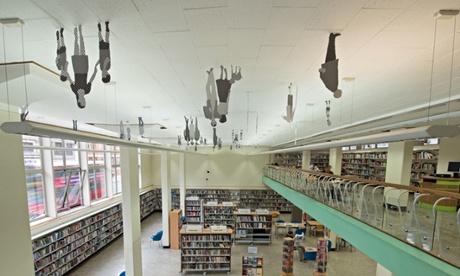
Pity our libraries, hit hard by austerity. Cut taxes, close a few more. Who cares?
Step forward Artangel, the public art agency with an almost mystical belief in the power of place. Artists working with Artangel have, over the years, tranformed sites from a south London flat to a field at Orgreave into vivid theatres of memory. Now it is the turn of Holborn library in central London to have its unconcscious excavated. Brazilian artist José Damasceno transfigures this quiet place of reading and study with an intervention of appropriately subtle imaginative power.
Holborn library opened in 1960 and, according to the Twentieth Century Society, represents “a milestone in the history of the modern public library”, the first ambitious modernist library of the postwar era. It has a sweeping glass and brick facade that fills the main reading room with natural light. Colourful mosaics sing of the optimism of the moment when it was built.
But that is now a faded optimism, and the building seems to be only just keeping it all together. The mustiness of underinvestment hangs in the air. Without that barely held back decay, Damasceno’s installations would not work, for they dig surreally into the building’s hidden, disused spaces.
In the main reading room, his additions are so gentle that they might go unnoticed or be mistaken for childrens’ craft work. There are mounds of paper footprints cut out of a 1960 encyclopedia. They represent Lilliputian footsteps – presumably alluding to the name of the first librarian, who happened to be one J Swift, like the author of Gulliver’s Travels.
On the ceiling, cutout figures of “modern”-looking 1960s people walk upside down in cool, sociable groups. They – and the library itself – look like pictures of modern life from the Ladybird books I read as a child. Eerie innocents.
The real heart of Damasceno’s investigation nestles upstairs, past more cutout footprints, in the library’s long-disused lecture theatre and cinema. The last time this room was used for a public event was, apparently, one organised by a Hammer Horror appreciation society about 20 years ago. Damasceno has warped its wood-floored interior in the strangest way. Shapes that resemble the abstract surrealism of Jean (Hans) Arp, who created biomorphic blobs of pure colour, rise from the floor. But what makes these big cloud or ink-stain-like shapes so curious is that they are made from wood the same colour as the room’s 1960s decor.
It as if the room has started to grow warts. They are pleasant, even useful – just the height to sit on – but there is an uncanny sense of dumb architecture starting to replicate itself inaccurately in a monstrous genetic mutation, unnoticed for decades.
This is true contemporary surrealism.
In the room where local historians consult Camden’s archives, a man of clay collapses across a desk. Made from blocks of the raw material, this sprawling form once again eerily reproduces the colours of its surroundings. The muted tones of the furniture blend uneasily into the grey mass of flaccid clay.
Photographs show how Damasceno discovered his curvy shapes by playing with a circle of string, in the best traditions of the dada and surrealist cult of chance. Another string “drawing” is translated into a soaring mural on the rear of the library’s exterior, an image of hope and freedom framed against the sky.
There is reading material, too. This is a library, after all. Reading Damasceno’s playscript adapted from a Monty Python sketch, I suddenly feel connected with the library’s generations of readers. All their imaginations, all those musty wonderlands, have come back as shapeless ghosts.
• Plot is at Holborn Library, London, from 3 October to 23 November.

